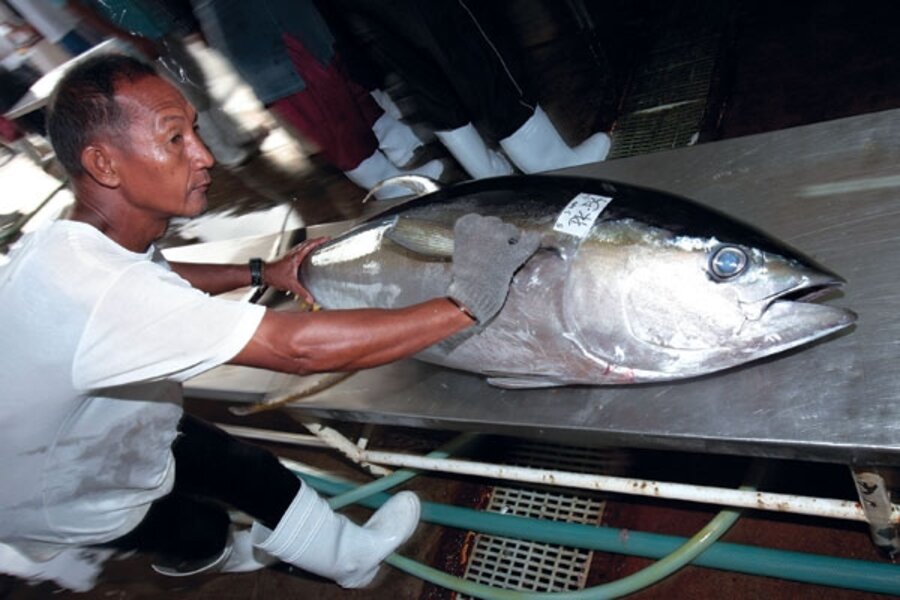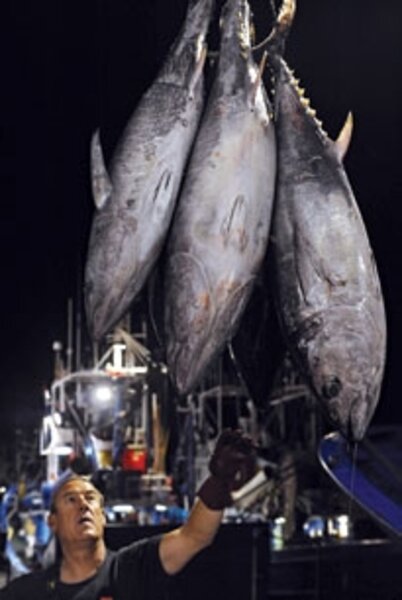Tuna’s plight is a problem the world must solve
Somewhere in the Pacific Ocean, a South Korean fishing vessel called the MFV Oryong 717 is hunting for fishing gear it left in the water to catch tuna. It won’t find it. Greenpeace has hauled it aboard their ship for disposal.
It’s just one more skirmish in an accelerating battle over the fate of one of the last great lions of the open ocean – the bluefin tuna. Its succulent flesh is so popular in sushi that its very existence is threatened. A single bluefin – they typically grow to eight feet and 800 pounds – may sell for $100,000 in Japan.
Such price tags, and humanity’s hunger for protein, have put a bull’s-eye not just on bluefin, but on scores of other species as well. Nine of 23 tuna species worldwide are “fully fished” – meaning catches should not be increased. Four more are “overexploited” or “depleted,” according to the United Nations’ Food
and Agriculture Organization (FAO).
The tuna’s plight is shared by many marine species now being hunted by large, modern fishing fleets that use satellite tracking and sophisticated fishing gear, scientists say.
Despite the fact that regional fishery management organizations have imposed catch limits to try to preserve tuna and other species, global fisheries are in crisis, researchers say. Some 80 percent of commercial fish species are either fully exploited, overexploited, or collapsed, the FAO reports.
“Global fisheries really are in bad shape,” says Daniel Pauly, a marine scientist at the University of British Columbia. “Most of it is due, quite simply, to decades of overfishing.” His research tracks a steady slide in global catches.
Now there are growing signs that the nations of the world may be waking up in time to pull back from the brink – if they can find and sustain the political will to do so, experts say.
The Obama administration, for instance, last month unveiled the outline of a comprehensive “ecosystem-based” plan to restore health to US ocean waters, including coastal fisheries. Among several measures, US fisheries would be pushed toward science-based instead of politically based catch limits.
If the plan works, the United States could become a global model: It controls more ocean in its 200-mile exclusive economic zones (EEZ) than any other
nation. Despite its own hard-hit fisheries (Georges Bank cod, for example), the US still has some of the best fisheries regulations in the world, experts say
Europe is taking action, too. Last month the European Commission moved to ban all trade in the most endangered Atlantic bluefin for two years. A final decision won’t come until a March meeting in Doha, Qatar. Despite resistance from Spain and other major fishing powers, the new measure seems likely to be approved. If so, Atlantic bluefin tuna will enjoy the same banned-trade status as ivory.
In the Pacific Ocean, meanwhile, a move is emerging to protect tuna from overfishing by international fishing fleets. Nearly 2.5 million metric tons of tuna were caught in the Pacific last year, a record catch. But many were juvenile fish, caught by “illegal, unreported, and unregulated” (IUU) fishing vessels.
Such “pirate fishing” is a huge problem in tuna fisheries across the western Pacific, particularly in “doughnut holes,” international waters between EEZ boundaries. In these waters, reflagged ships often use fish aggregating devices (FADs) that attract juvenile yellowfin tuna.
Globally, $9 billion is lost to so-called pirate fishing, according to a study last year by the University of British Columbia and Marine Resource Assessment Group. In the Pacific alone, IUU fishing takes 36 percent of the total catch, compared with a 19 percent global average.
In a first-ever agreement, the Western and Central Pacific Fisheries Commission (WCPFC) – whose 25 member nations include the European Union, the US, Taiwan, China, and Japan – will halt all tuna fishing in two of four Pacific doughnut holes next year. The EU has also adopted new rules to curb IUU fishing that take effect in January.
In one of its most significant steps, the WCPFC put a two-month ban (August and September) on the use of FADs. The devices, usually buoys, are often linked by satellite, and underwater cameras monitor fish densities until they reach a peak. Trawlers then come to scoop up the fish.
Such steps may be the foundation for a larger global shift toward tougher catch limits, stricter enforcement, lower national fishing subsidies, and the downsizing of overbuilt fishing fleets.
“Action finally has been taken in some places – and where it is being taken, things are turning around,” says Boris Worm, an associate professor of marine conservation biology at Dalhousie University in Halifax, Nova Scotia.
In seven of 10 key marine ecosystems worldwide where exploitation rates were at or below the rate required to maintain a sustainable catch, the fisheries were recovering, he and other researchers reported in a study in Science this summer. They also noted four aspects that well-managed fisheries shared:
•Restricting gear that is too good at catching fish. Nets with larger holes let younger fish escape, for example.
•Closing hard-hit and breeding areas to fishing to let them recover.
•Drastically reducing the number of fishing vessels chasing the fish.
•Reducing the total allowable catch.
Some “cynically imply it’s just human nature – that we cannot halt the decline in fisheries before a complete collapse,” Dr. Worm says. “I don’t believe that. Our research shows we can stop it if we want to – if we muster the political will.”
Still, Worm is circumspect, given the track record of even highly developed nations like his own country, Canada. Major species like the Atlantic cod were once abundant in the Gulf of St. Lawrence, but were eliminated as a commercial species by “factory fishing” in the 1990s – and have not returned in strong numbers.
Today, less than 1 percent of the southern Gulf cod biomass of the 1950s remains, fewer than 40,000 tons of fish overall, a Canadian government study last year found. That’s not nearly enough to be a viable commercial fishery. Surprisingly, the cod that remain were still being fished – up to 2,000 tons a year, through last year, a rate that would have ensured its demise. This year Canada is permitting just 300 tons of the cod – enough to cover scientific studies and bycatch by other fisheries, and perhaps keep it from extinction.
In US East Coast waters, meanwhile, where cod was hit hard by overfishing, although not as hard as Canada’s southern Gulf cod, the cod biomass is ever so slowly rebuilding, and fishing restrictions on them remain tight.
“With cod ... it was pretty clear we weren’t being nearly conservative enough,” says Andrew Rosenberg, a professor of natural resources at the University of New Hampshire in Durham and an adviser to Obama’s Interagency Ocean Task Force.
“We have this bizarre notion that we are able to fish well beyond what’s sustainable – and then expect [the fish] to recover,” he says. “But you can’t just have them magically do that. You have to change the exploitation rate. It’s all about what happens in the water.”
Meanwhile, back in the western Pacific, the Greenpeace ship Esperanza and her crew have been busily scooping up tons of illegal FADs and other tuna fishing equipment it contends is also illegitimate.
Though this region is by far the healthiest of the world’s tuna fisheries, the decline of other regions means it now provides half of the global tuna catch – an unsustainable rate, says Phil Kline, senior oceans campaigner for Greenpeace.
“We’re on the knife edge,” he says. “What typically happens is commercial extinction followed later by biological collapse. We don’t want to see that here.”
Editor’s note: To read more about the environmental issues concerning tuna, read this article about sustainable sushi or check out this article about efforts being taken to restore the bluefin tuna population.
For more articles about the environment, see the Monitor’s main environment page, which offers information on many environment topics. Also, check out our Bright Green blog archive and our RSS feed.






